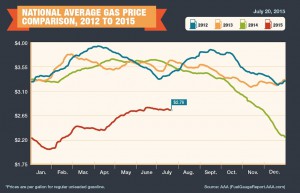A growing controversy over specially blended gasoline used during the summer has helped put a floor under gasoline prices nationwide despite the continuing drop in the price of crude oil, which is now trading at prices approaching $50 per barrel.
The average price nationwide of $2.76 per gallon, according to AAA, is the lowest average for this date since 2010 and is down nearly a nickel per gallon compared to the 2015 peak price reached on June 15 if $2.80 per gallon. National pump prices have slowly pulled back from this peak with averages down by 1 cent per gallon versus one week ago and 4 cents per gallon versus one month ago.
The relatively stable national average continues to disguise volatility in select markets, particularly in California where drivers are paying the highest averages since August 2014 after a jump of 16 cents per gallon, largely due to imbalances between gasoline supply and demand.
A lack of imports and the blending components used to make the special gasoline mandated on the West Coast, are also reported to be dwindling and retail averages are expected to remain high, touching off new arguments over the state’s tough regulatory environment. Ongoing refinery problems, particularly at the ExxonMobil facility in Torrance, California, also are playing a significant role in the state’s high gas prices.
Meanwhile, the averages prices in parts of the Great Lakes region are moving lower, following the resolution of regional supply issues.
California at $3.87 per gallon remains the nation’s most expensive market for retail gasoline, due supply difficulties. Bi-weekly price comparisons show pump prices that have spiked 44 cents per gallon, however prices have leveled off over the weekend.
Alaska, Hawaii, Nevada and Washington round out the top five most expensive markets for retail gasoline, while consumers in South Carolina at $2.37 and Alabama $2.41 per gallon are paying the lowest prices at the pump.
(Stockholm banning cars for a day to mark European Mobility Week. For more, Click Here.)
Pump prices across much of the country have remained relatively stable week-over-week, with prices moving by only 3 cents per gallon overall in 25 states and Washington, D.C.
Weekly comparisons reflect double-digit movements in a handful of states, though fluctuations are less dramatic than in previous price reports.
(Click Here to see how hackers ran a Jeep Cherokee off the road.)
Retail averages are down in 32 states and Washington, D.C. month-over-month, and 12 states are posting double-digit savings over that time. Motorists in Indiana, Michigan and Illinois are experiencing the largest monthly discounts, and the price is down by a nickel or more per gallon in 30 states.
Following the nuclear deal that was reached last week between Iran and China, France, Russia, the United Kingdom, the United States and Germany, the prospect for Iranian crude oil to return to the global market has become a distinct possibility. Although the timeline for the possible return and at what quantity remains in question, downward pressure is expected to remain on global oil prices as a result of the news.
(To see more about the latest APEAL results, and how the Korean makers cleaned up again, Click Here.)
At the close of last week’s formal trading on the NYMEX, tested the $50 per barrel mark and closed down two cents at $50.89 per barrel.


The pump prices on the West coast have NOTHING to do with “special blends” and everything to do with an industry monopoly where supply and demand only works if the refinery storage capacity is maxed out and they need to move fuel quickly or stop production – which is too costly.
It’s sad those in the media never research the facts instead of reporting the dribble disseminated by unscrupulous entities who shape public opinion based on deception.